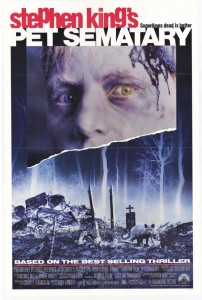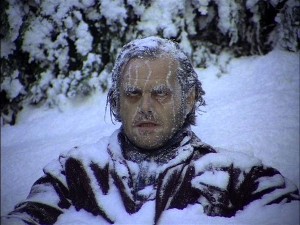Clowns, prom, pets, and family getaways have two things in common: we’re supposed to feel safe about them and, because of Stephen King, we don’t. Considered to be the master of modern horror, King takes our expectations of what it means to be safe and secure, and flips it on its head. So sit back and relax as Sound on Sight explores the five most frightening screen adaptations of Stephen King for the 31 Days of Horror.
5- It (1990)
Childhood for many of us consists of days spent outdoors under the sun, playing make-believe, and an innocence that can never be recaptured. It’s a time in our lives when we trust those around us, believe the white lies we’re told by our parents, and find comfort in friendship, not deal with child-eating clowns that live in the sewer beneath our feet.
Which is why the television miniseries It finds its way onto our list. A story about a group of adults who must face the demonic clown that terrorized their childhood, this two-episode show is bound to put a scare in even the bravest of souls. King takes childhood and twists it into a nightmarish experience that will mark and define these kids well into adulthood. He singlehandedly turns clowns, supposed to be synonymous with birthday parties and fun, from a symbol of childhood innocence to one of malicious intent and death.
Plus, who can forget watching seeing a helpless Georgie fall victim to It by making the fatal error to trust the sewer-lurking clown?
4- Pet Sematary (1989)
Losing a pet is one of the most difficult things we can go through in our lives. Knowing the animal that we raised, trained, and unconditionally loved is now gone leaves a toll on all of us. The hole they leave in our lives can never really be filled, even after a new pet is found, and we’ve all wished we could bring our pet back from the grave.
But what if we could? And what if Rex, Sparky, or Bingo came back wrong? What happens when the animal that goes in the ground comes out of it different?
Coming in at number four is Pet Sematary, directed by Mary Lambert and staring Dale Midkiff. In the film adaptation of one of King’s most beloved (and feared) books, we follow the story of the Creed family and how far they’ll go to repair their family. After their son is hit by a truck on a nearby road, Louis buries his young son in the enchanted pet cemetery (known for bringing dead animals back to life). However, when his son comes back to him, he’s wrong. Something isn’t right about the littlest Creed, which becomes even more apparent as he terrorizes his family.
Pet Sematary is especially frightening because it twists and bends what we know. We know the dead stay dead and we know our family. Yet in this film, the dead can walk again but they’re not who they once were. There’s something that’s turned ugly in them, and who comes out of the pet cemetery isn’t who we put in it. The film also plays with the idea that perhaps some things, such as death, aren’t meant to be undone. That, as the tagline for the movie says, “sometimes dead is better.”
3- Carrie (1976)
High school isn’t fun for everyone. We can’t all be the popular jock or the beautiful cheerleading bombshell, but that isn’t to say it’s a nightmare for everyone. Unless, of course, you happened to attend prom with a telekinetic girl who just happens to be a bit of a hothead.
At number three is the 1976 version of Carrie, directed by Brian de Palma and staring Sissy Spacek. The tale of a troubled girl, raised in a religious home by her mother and made an outcast by her peers, Carrie believes she’s finally begun to fit in after she’s asked out to prom. Unfortunately, she’s then humiliated in front of everyone, in a scheme that involving a bucket of pig’s blood, and in a fit of telepathic rage, she burns the school down around her peers at the dance.
Fun stuff.
Carrie’s a film that easily keeps audiences glued to their seat. King destroys her innocence while creating an atmosphere of absolute terror, yet still building up a compelling character in the god-fearing firebug. Carrie’s a vision of innocence at the beginning of the film, a kind girl albeit a bit weird, with not a violent bone in her body. However as Carrie’s pushed to emotional extremes, we witness her snap and lose all control, which leads to the death of her classmates in a heart pounding scene come the end of the film.
2- The Shining (1980)
Nothing sounds better than spending some quality time with the family, especially if said time is in a quiet hotel in the middle of nowhere. Getting alone time with your parents and having some free time to unwind doesn’t sound too shabby in this day and age of constant work and activity.
Unless the hotel’s actually haunted and the ghosts have convinced your dad that hacking you up with an axe is the way to spend the weekend. In which case, it isn’t all that much fun. Which is why in second place is The Shining, directed by Stanley Kubrick and starring Jack Nicholson.
As is the way of Stephen King, he twists and turns our expectations of safety and the known. He takes what could have been a great work experience for a family in an isolated hotel, away from the hustle and bustle of everyday life, and turns it into a scene straight from hell. Parents are supposed to represent safety and love, yet the father hunts down his son and tries to chop him to bits. We’re supposed to believe in free will, yet it’s undercut by this idea of the father resuming his place amongst the ghosts of the hotel, that he always belonged to the dead and never had a say in the realm of the living.
Still horrifying all these years later, The Shining easily earns its place the top five works of Stephen King.

1. Misery (1990)
Taking the top spot on our list is Misery, directed by Rob Reiner, and starring James Caan and Kathy Bates. It’s the story of author Paul Sheldon, who crashes his car while off in the woods, alone, in order to write, and finds himself saved by his biggest fan. “Saved” is less accurate, and he’s more “held captive and forced to write to save his life” than rescued.
Misery plays on the concept of solitude. While Sheldon is alone and injured in the woods, as an audience, we fear for him, worried that without people close at hand he’ll surely die. Then, thankfully, Annie (Bates) shows up and we believe all will be well. Except in true King fashion, it isn’t the case. Sheldon may have been safer alone in the woods, left to fend for himself on the abandoned winter road. Then, upon his kidnapping, he’s further isolated from humanity as Annie keeps him hidden from those looking to find him. What seems like kindness and warmth at first is soon shown to be insanity. King turns what would normally have been perceived as a rescue from a kind woman into abduction by a psychopath.
And if that wasn’t enough to scare you, who will ever forget the scene with Sheldon’s hobbling? Horrific, iconic, and not a scene to soon be forgotten, it’s no wonder Misery finds itself at number one.
— Caitlin Marceau





